Understanding Behavior for Classroom Practice Report
VerifiedAdded on 2020/04/15
|9
|2273
|63
AI Summary
Contribute Materials
Your contribution can guide someone’s learning journey. Share your
documents today.
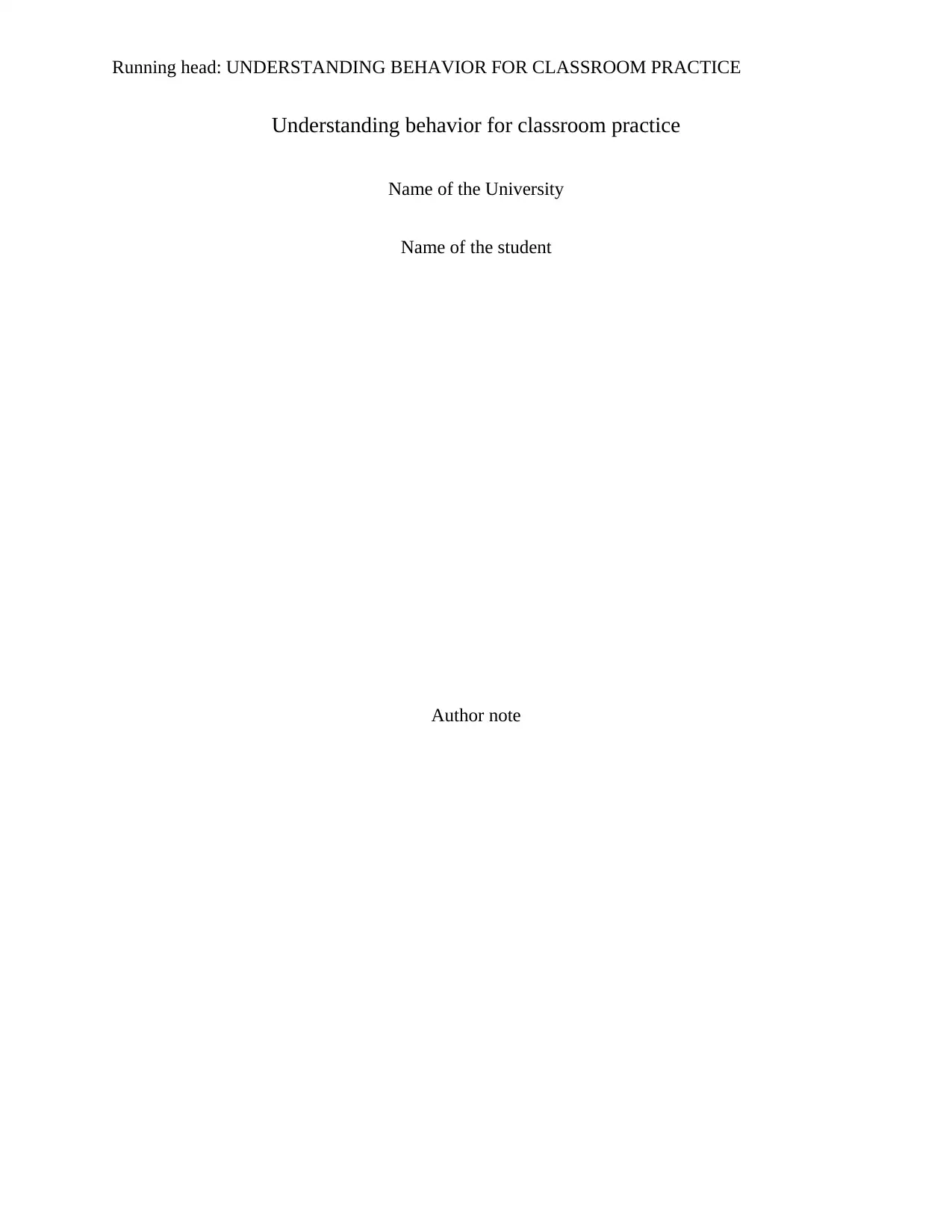
Running head: UNDERSTANDING BEHAVIOR FOR CLASSROOM PRACTICE
Understanding behavior for classroom practice
Name of the University
Name of the student
Author note
Understanding behavior for classroom practice
Name of the University
Name of the student
Author note
Secure Best Marks with AI Grader
Need help grading? Try our AI Grader for instant feedback on your assignments.

1UNDERSTANDING BEHAVIOR FOR CLASSROOM PRACTICE
Introduction
Behavior, in general sense refers to the way one behaves in certain environment.
However, an individual’s behavior depends on several factors including psychological and
physical. In particular, the variations in children’s behavior are a result of a number of factors.
Children have the tendency to observe and follow the behavior of the people around them
especially elders (Smith, Cowie & Blades, 2015).
The given essay focuses on the behavior of children particularly in learning environment.
Further, it elaborates on the assumption that children with limited capability to interact with their
peers, self-regulation and holding on to learning tasks are at danger for school difficulties.
The essay also gives a description of behavior as defined by the socio-cultural theorists.
In addition, the essay formulates the reasons for children’s behavior as mentioned in the quote
with proper reference to the selected theory.
Defining behavior
According to the socio-cultural theory, human behavior is defined by the cultural
environment and interactions with the society. Lev Semyonovich Vygotsky, the father of socio-
culturalism believed that a child’s cognitive process and his perception of the world are shaped
by the way he interacts with the world. He also stated that the means by which children learn and
grow differs in different cultures and is often explicit to each individual culture. Further, he
claimed that even as each culture may have unique cognitive processes, the manner in which
they are passed on from one generation to the other is mostly similar.
According to Vygotsky, children can be taught through three methods- imitative learning,
collaborative learning and instructed learning (Glăveanu & Tanggaard, 2014). One of the central
Introduction
Behavior, in general sense refers to the way one behaves in certain environment.
However, an individual’s behavior depends on several factors including psychological and
physical. In particular, the variations in children’s behavior are a result of a number of factors.
Children have the tendency to observe and follow the behavior of the people around them
especially elders (Smith, Cowie & Blades, 2015).
The given essay focuses on the behavior of children particularly in learning environment.
Further, it elaborates on the assumption that children with limited capability to interact with their
peers, self-regulation and holding on to learning tasks are at danger for school difficulties.
The essay also gives a description of behavior as defined by the socio-cultural theorists.
In addition, the essay formulates the reasons for children’s behavior as mentioned in the quote
with proper reference to the selected theory.
Defining behavior
According to the socio-cultural theory, human behavior is defined by the cultural
environment and interactions with the society. Lev Semyonovich Vygotsky, the father of socio-
culturalism believed that a child’s cognitive process and his perception of the world are shaped
by the way he interacts with the world. He also stated that the means by which children learn and
grow differs in different cultures and is often explicit to each individual culture. Further, he
claimed that even as each culture may have unique cognitive processes, the manner in which
they are passed on from one generation to the other is mostly similar.
According to Vygotsky, children can be taught through three methods- imitative learning,
collaborative learning and instructed learning (Glăveanu & Tanggaard, 2014). One of the central
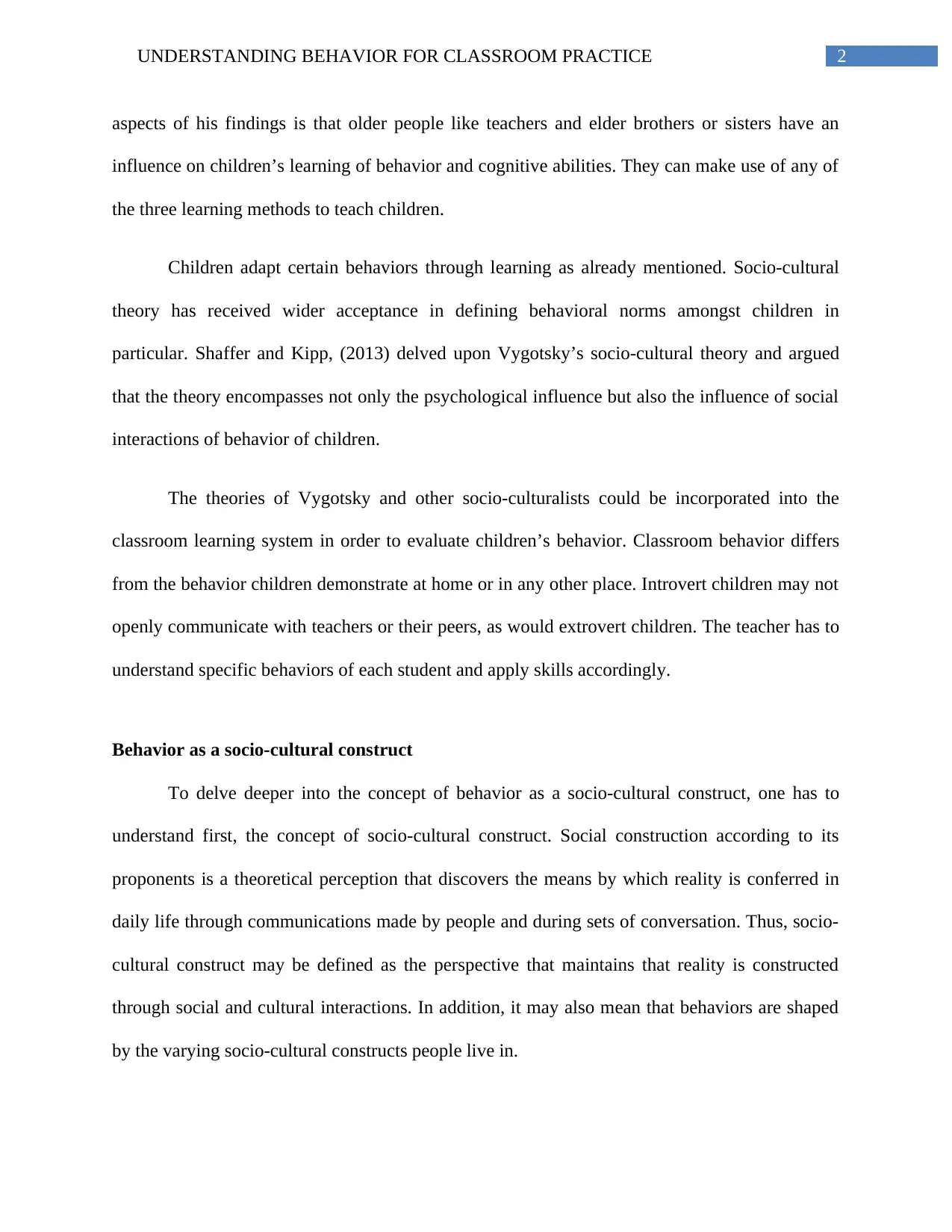
2UNDERSTANDING BEHAVIOR FOR CLASSROOM PRACTICE
aspects of his findings is that older people like teachers and elder brothers or sisters have an
influence on children’s learning of behavior and cognitive abilities. They can make use of any of
the three learning methods to teach children.
Children adapt certain behaviors through learning as already mentioned. Socio-cultural
theory has received wider acceptance in defining behavioral norms amongst children in
particular. Shaffer and Kipp, (2013) delved upon Vygotsky’s socio-cultural theory and argued
that the theory encompasses not only the psychological influence but also the influence of social
interactions of behavior of children.
The theories of Vygotsky and other socio-culturalists could be incorporated into the
classroom learning system in order to evaluate children’s behavior. Classroom behavior differs
from the behavior children demonstrate at home or in any other place. Introvert children may not
openly communicate with teachers or their peers, as would extrovert children. The teacher has to
understand specific behaviors of each student and apply skills accordingly.
Behavior as a socio-cultural construct
To delve deeper into the concept of behavior as a socio-cultural construct, one has to
understand first, the concept of socio-cultural construct. Social construction according to its
proponents is a theoretical perception that discovers the means by which reality is conferred in
daily life through communications made by people and during sets of conversation. Thus, socio-
cultural construct may be defined as the perspective that maintains that reality is constructed
through social and cultural interactions. In addition, it may also mean that behaviors are shaped
by the varying socio-cultural constructs people live in.
aspects of his findings is that older people like teachers and elder brothers or sisters have an
influence on children’s learning of behavior and cognitive abilities. They can make use of any of
the three learning methods to teach children.
Children adapt certain behaviors through learning as already mentioned. Socio-cultural
theory has received wider acceptance in defining behavioral norms amongst children in
particular. Shaffer and Kipp, (2013) delved upon Vygotsky’s socio-cultural theory and argued
that the theory encompasses not only the psychological influence but also the influence of social
interactions of behavior of children.
The theories of Vygotsky and other socio-culturalists could be incorporated into the
classroom learning system in order to evaluate children’s behavior. Classroom behavior differs
from the behavior children demonstrate at home or in any other place. Introvert children may not
openly communicate with teachers or their peers, as would extrovert children. The teacher has to
understand specific behaviors of each student and apply skills accordingly.
Behavior as a socio-cultural construct
To delve deeper into the concept of behavior as a socio-cultural construct, one has to
understand first, the concept of socio-cultural construct. Social construction according to its
proponents is a theoretical perception that discovers the means by which reality is conferred in
daily life through communications made by people and during sets of conversation. Thus, socio-
cultural construct may be defined as the perspective that maintains that reality is constructed
through social and cultural interactions. In addition, it may also mean that behaviors are shaped
by the varying socio-cultural constructs people live in.

3UNDERSTANDING BEHAVIOR FOR CLASSROOM PRACTICE
Behavior is defined by the realities experienced by people in their lives. Realities come
from the popular social and cultural discourses that define how people live. Perceived through
the realms of reality based on experience, behavior is shaped by the experiences each individual
receives throughout life. Cultures across ages have had either positive or negative impact on the
behavior of children. The attitude or behavior of a child depends on the dominance of the culture
he or she belongs to, in the society. A child coming from a religion-dominated culture would be
reluctant to engage in behavior that permits disrespect of elders or even being friendly. Similarly,
a child hailing from western culture would be more open-minded and not bounded by the family
or community.
To a child, these experiences begin as cognitive, and then take the form of social and
cultural. Schools play an important role in shaping a child’s behavior. The basic structuring of a
child’s behavior begins at school because it is the first place where children from varying
cultures and social backgrounds come together to learn. It is thus extremely important for the
teachers to understand the requirements of each student and their behavioral pattern. It is an
established fact that every classroom will have children who demonstrate aggressive, repulsive,
dominant and opposite behaviors. An understanding of the psychological factors could assist
understanding the reasons behind a child’s differing behavior.
The emergence of social constructionism and its blending with culture formulated a new
field of study for behavior- the socio-cultural constructionist theory. Before the arrival of this
theory, an individual’s growth is not dependent on group culture. Hence, a child’s behavior as he
grows, according to the previous theory, is independent of the culture that he grows up. Socio-
cultural constructionist theory rejected this view and argued that social and cultural interactions
are the basis of an individual’s growth.
Behavior is defined by the realities experienced by people in their lives. Realities come
from the popular social and cultural discourses that define how people live. Perceived through
the realms of reality based on experience, behavior is shaped by the experiences each individual
receives throughout life. Cultures across ages have had either positive or negative impact on the
behavior of children. The attitude or behavior of a child depends on the dominance of the culture
he or she belongs to, in the society. A child coming from a religion-dominated culture would be
reluctant to engage in behavior that permits disrespect of elders or even being friendly. Similarly,
a child hailing from western culture would be more open-minded and not bounded by the family
or community.
To a child, these experiences begin as cognitive, and then take the form of social and
cultural. Schools play an important role in shaping a child’s behavior. The basic structuring of a
child’s behavior begins at school because it is the first place where children from varying
cultures and social backgrounds come together to learn. It is thus extremely important for the
teachers to understand the requirements of each student and their behavioral pattern. It is an
established fact that every classroom will have children who demonstrate aggressive, repulsive,
dominant and opposite behaviors. An understanding of the psychological factors could assist
understanding the reasons behind a child’s differing behavior.
The emergence of social constructionism and its blending with culture formulated a new
field of study for behavior- the socio-cultural constructionist theory. Before the arrival of this
theory, an individual’s growth is not dependent on group culture. Hence, a child’s behavior as he
grows, according to the previous theory, is independent of the culture that he grows up. Socio-
cultural constructionist theory rejected this view and argued that social and cultural interactions
are the basis of an individual’s growth.
Secure Best Marks with AI Grader
Need help grading? Try our AI Grader for instant feedback on your assignments.
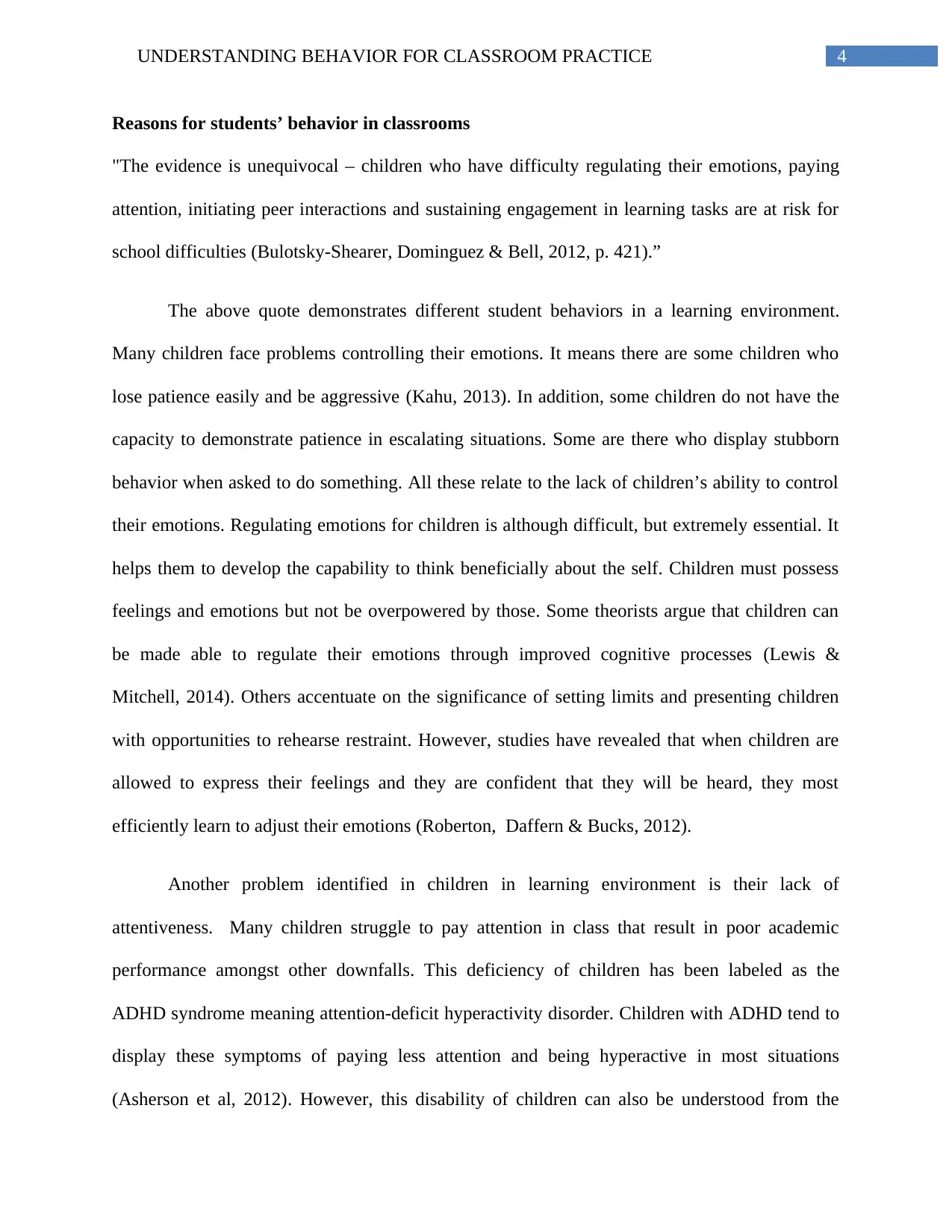
4UNDERSTANDING BEHAVIOR FOR CLASSROOM PRACTICE
Reasons for students’ behavior in classrooms
"The evidence is unequivocal – children who have difficulty regulating their emotions, paying
attention, initiating peer interactions and sustaining engagement in learning tasks are at risk for
school difficulties (Bulotsky-Shearer, Dominguez & Bell, 2012, p. 421).”
The above quote demonstrates different student behaviors in a learning environment.
Many children face problems controlling their emotions. It means there are some children who
lose patience easily and be aggressive (Kahu, 2013). In addition, some children do not have the
capacity to demonstrate patience in escalating situations. Some are there who display stubborn
behavior when asked to do something. All these relate to the lack of children’s ability to control
their emotions. Regulating emotions for children is although difficult, but extremely essential. It
helps them to develop the capability to think beneficially about the self. Children must possess
feelings and emotions but not be overpowered by those. Some theorists argue that children can
be made able to regulate their emotions through improved cognitive processes (Lewis &
Mitchell, 2014). Others accentuate on the significance of setting limits and presenting children
with opportunities to rehearse restraint. However, studies have revealed that when children are
allowed to express their feelings and they are confident that they will be heard, they most
efficiently learn to adjust their emotions (Roberton, Daffern & Bucks, 2012).
Another problem identified in children in learning environment is their lack of
attentiveness. Many children struggle to pay attention in class that result in poor academic
performance amongst other downfalls. This deficiency of children has been labeled as the
ADHD syndrome meaning attention-deficit hyperactivity disorder. Children with ADHD tend to
display these symptoms of paying less attention and being hyperactive in most situations
(Asherson et al, 2012). However, this disability of children can also be understood from the
Reasons for students’ behavior in classrooms
"The evidence is unequivocal – children who have difficulty regulating their emotions, paying
attention, initiating peer interactions and sustaining engagement in learning tasks are at risk for
school difficulties (Bulotsky-Shearer, Dominguez & Bell, 2012, p. 421).”
The above quote demonstrates different student behaviors in a learning environment.
Many children face problems controlling their emotions. It means there are some children who
lose patience easily and be aggressive (Kahu, 2013). In addition, some children do not have the
capacity to demonstrate patience in escalating situations. Some are there who display stubborn
behavior when asked to do something. All these relate to the lack of children’s ability to control
their emotions. Regulating emotions for children is although difficult, but extremely essential. It
helps them to develop the capability to think beneficially about the self. Children must possess
feelings and emotions but not be overpowered by those. Some theorists argue that children can
be made able to regulate their emotions through improved cognitive processes (Lewis &
Mitchell, 2014). Others accentuate on the significance of setting limits and presenting children
with opportunities to rehearse restraint. However, studies have revealed that when children are
allowed to express their feelings and they are confident that they will be heard, they most
efficiently learn to adjust their emotions (Roberton, Daffern & Bucks, 2012).
Another problem identified in children in learning environment is their lack of
attentiveness. Many children struggle to pay attention in class that result in poor academic
performance amongst other downfalls. This deficiency of children has been labeled as the
ADHD syndrome meaning attention-deficit hyperactivity disorder. Children with ADHD tend to
display these symptoms of paying less attention and being hyperactive in most situations
(Asherson et al, 2012). However, this disability of children can also be understood from the
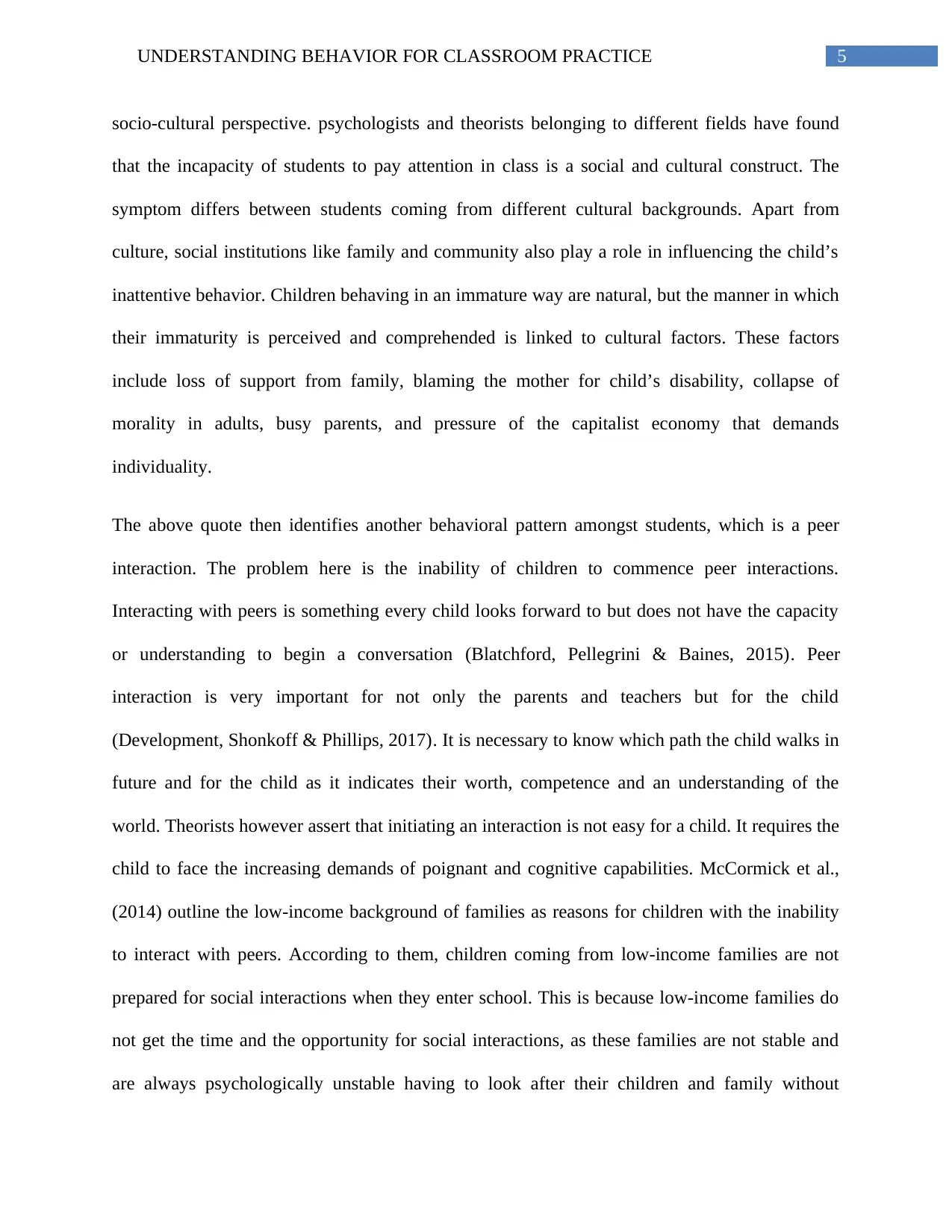
5UNDERSTANDING BEHAVIOR FOR CLASSROOM PRACTICE
socio-cultural perspective. psychologists and theorists belonging to different fields have found
that the incapacity of students to pay attention in class is a social and cultural construct. The
symptom differs between students coming from different cultural backgrounds. Apart from
culture, social institutions like family and community also play a role in influencing the child’s
inattentive behavior. Children behaving in an immature way are natural, but the manner in which
their immaturity is perceived and comprehended is linked to cultural factors. These factors
include loss of support from family, blaming the mother for child’s disability, collapse of
morality in adults, busy parents, and pressure of the capitalist economy that demands
individuality.
The above quote then identifies another behavioral pattern amongst students, which is a peer
interaction. The problem here is the inability of children to commence peer interactions.
Interacting with peers is something every child looks forward to but does not have the capacity
or understanding to begin a conversation (Blatchford, Pellegrini & Baines, 2015). Peer
interaction is very important for not only the parents and teachers but for the child
(Development, Shonkoff & Phillips, 2017). It is necessary to know which path the child walks in
future and for the child as it indicates their worth, competence and an understanding of the
world. Theorists however assert that initiating an interaction is not easy for a child. It requires the
child to face the increasing demands of poignant and cognitive capabilities. McCormick et al.,
(2014) outline the low-income background of families as reasons for children with the inability
to interact with peers. According to them, children coming from low-income families are not
prepared for social interactions when they enter school. This is because low-income families do
not get the time and the opportunity for social interactions, as these families are not stable and
are always psychologically unstable having to look after their children and family without
socio-cultural perspective. psychologists and theorists belonging to different fields have found
that the incapacity of students to pay attention in class is a social and cultural construct. The
symptom differs between students coming from different cultural backgrounds. Apart from
culture, social institutions like family and community also play a role in influencing the child’s
inattentive behavior. Children behaving in an immature way are natural, but the manner in which
their immaturity is perceived and comprehended is linked to cultural factors. These factors
include loss of support from family, blaming the mother for child’s disability, collapse of
morality in adults, busy parents, and pressure of the capitalist economy that demands
individuality.
The above quote then identifies another behavioral pattern amongst students, which is a peer
interaction. The problem here is the inability of children to commence peer interactions.
Interacting with peers is something every child looks forward to but does not have the capacity
or understanding to begin a conversation (Blatchford, Pellegrini & Baines, 2015). Peer
interaction is very important for not only the parents and teachers but for the child
(Development, Shonkoff & Phillips, 2017). It is necessary to know which path the child walks in
future and for the child as it indicates their worth, competence and an understanding of the
world. Theorists however assert that initiating an interaction is not easy for a child. It requires the
child to face the increasing demands of poignant and cognitive capabilities. McCormick et al.,
(2014) outline the low-income background of families as reasons for children with the inability
to interact with peers. According to them, children coming from low-income families are not
prepared for social interactions when they enter school. This is because low-income families do
not get the time and the opportunity for social interactions, as these families are not stable and
are always psychologically unstable having to look after their children and family without

6UNDERSTANDING BEHAVIOR FOR CLASSROOM PRACTICE
economic backup. Classroom interactions might help these students to improve their social skills
and establish a good rapport with their peers enabling them to succeed further (Black &
Fernando, 2014).
Conclusion
It thus can be said that behavior of children in learning environment can be better
understood from the perspective of the socio-cultural theory. Society and culture undoubtedly
have an all-encompassing effect on the behavior of a child. The essay highlights the arguments
and reasons for approaching this behavior problem of students through the socio-cultural theory.
Further, behavior has been defined as per the theory. In addition to it, the theory has been applied
to provide reasons for the behavioral problems identified in the quote. Other perspectives have
been mentioned as well to compare and establish that the chosen theory is apt to understand
behavior problem amongst students in learning environment.
economic backup. Classroom interactions might help these students to improve their social skills
and establish a good rapport with their peers enabling them to succeed further (Black &
Fernando, 2014).
Conclusion
It thus can be said that behavior of children in learning environment can be better
understood from the perspective of the socio-cultural theory. Society and culture undoubtedly
have an all-encompassing effect on the behavior of a child. The essay highlights the arguments
and reasons for approaching this behavior problem of students through the socio-cultural theory.
Further, behavior has been defined as per the theory. In addition to it, the theory has been applied
to provide reasons for the behavioral problems identified in the quote. Other perspectives have
been mentioned as well to compare and establish that the chosen theory is apt to understand
behavior problem amongst students in learning environment.
Paraphrase This Document
Need a fresh take? Get an instant paraphrase of this document with our AI Paraphraser

7UNDERSTANDING BEHAVIOR FOR CLASSROOM PRACTICE
References:
Asherson, P., Akehurst, R., Kooij, J. S., Huss, M., Beusterien, K., Sasané, R., ... & Hodgkins, P.
(2012). Under diagnosis of adult ADHD: cultural influences and societal burden. Journal of
Attention Disorders, 16(5_suppl), 20S-38S.
Black, D. S., & Fernando, R. (2014). Mindfulness training and classroom behavior among lower-
income and ethnic minority elementary school children. Journal of child and family
studies, 23(7), 1242-1246.
Blatchford, P., Pellegrini, A. D., & Baines, E. (2015). The child at school: Interactions with
peers and teachers. Routledge.
Bulotsky-Shearer, R. J., Dominguez, X., & Bell, E. R. (2012). Preschool classroom behavioral
context and school readiness outcomes for low-income children: A multilevel examination of
child-and classroom-level influences. Journal of Educational Psychology, 104(2), 421.
Development, N., Shonkoff, J., & Phillips, D. (2017). Making Friends and Getting Along with
Peers. Ncbi.nlm.nih.gov. Retrieved 17 November 2017, from
https://www.ncbi.nlm.nih.gov/books/NBK225544/
Glăveanu, V. P., & Tanggaard, L. (2014). Creativity, identity, and representation: Towards a
socio-cultural theory of creative identity. New Ideas in Psychology, 34, 12-21.
Kahu, E. R. (2013). Framing student engagement in higher education. Studies in higher
education, 38(5), 758-773.
Lewis, C., & Mitchell, P. (2014). Children's early understanding of mind: Origins and
development. Psychology Press.
References:
Asherson, P., Akehurst, R., Kooij, J. S., Huss, M., Beusterien, K., Sasané, R., ... & Hodgkins, P.
(2012). Under diagnosis of adult ADHD: cultural influences and societal burden. Journal of
Attention Disorders, 16(5_suppl), 20S-38S.
Black, D. S., & Fernando, R. (2014). Mindfulness training and classroom behavior among lower-
income and ethnic minority elementary school children. Journal of child and family
studies, 23(7), 1242-1246.
Blatchford, P., Pellegrini, A. D., & Baines, E. (2015). The child at school: Interactions with
peers and teachers. Routledge.
Bulotsky-Shearer, R. J., Dominguez, X., & Bell, E. R. (2012). Preschool classroom behavioral
context and school readiness outcomes for low-income children: A multilevel examination of
child-and classroom-level influences. Journal of Educational Psychology, 104(2), 421.
Development, N., Shonkoff, J., & Phillips, D. (2017). Making Friends and Getting Along with
Peers. Ncbi.nlm.nih.gov. Retrieved 17 November 2017, from
https://www.ncbi.nlm.nih.gov/books/NBK225544/
Glăveanu, V. P., & Tanggaard, L. (2014). Creativity, identity, and representation: Towards a
socio-cultural theory of creative identity. New Ideas in Psychology, 34, 12-21.
Kahu, E. R. (2013). Framing student engagement in higher education. Studies in higher
education, 38(5), 758-773.
Lewis, C., & Mitchell, P. (2014). Children's early understanding of mind: Origins and
development. Psychology Press.
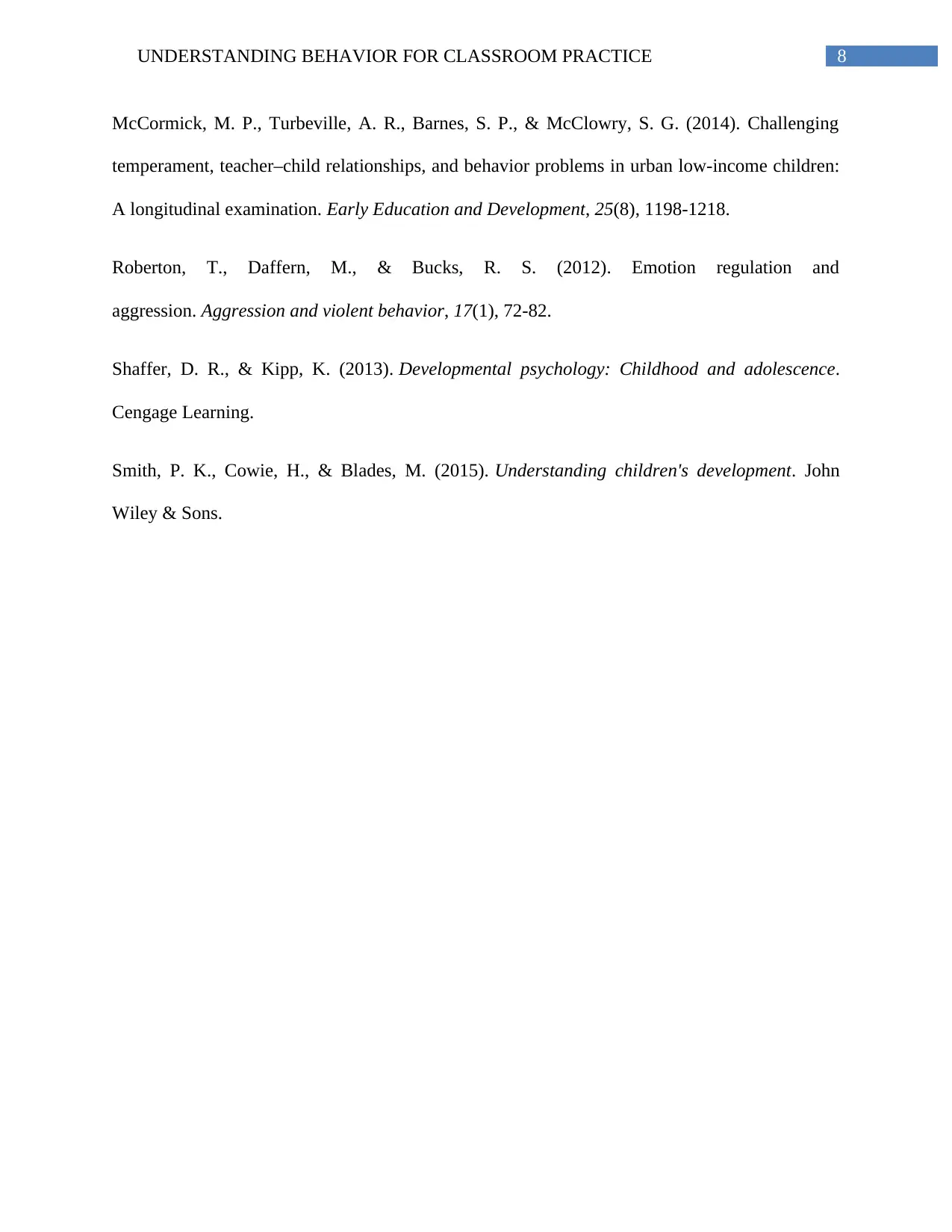
8UNDERSTANDING BEHAVIOR FOR CLASSROOM PRACTICE
McCormick, M. P., Turbeville, A. R., Barnes, S. P., & McClowry, S. G. (2014). Challenging
temperament, teacher–child relationships, and behavior problems in urban low-income children:
A longitudinal examination. Early Education and Development, 25(8), 1198-1218.
Roberton, T., Daffern, M., & Bucks, R. S. (2012). Emotion regulation and
aggression. Aggression and violent behavior, 17(1), 72-82.
Shaffer, D. R., & Kipp, K. (2013). Developmental psychology: Childhood and adolescence.
Cengage Learning.
Smith, P. K., Cowie, H., & Blades, M. (2015). Understanding children's development. John
Wiley & Sons.
McCormick, M. P., Turbeville, A. R., Barnes, S. P., & McClowry, S. G. (2014). Challenging
temperament, teacher–child relationships, and behavior problems in urban low-income children:
A longitudinal examination. Early Education and Development, 25(8), 1198-1218.
Roberton, T., Daffern, M., & Bucks, R. S. (2012). Emotion regulation and
aggression. Aggression and violent behavior, 17(1), 72-82.
Shaffer, D. R., & Kipp, K. (2013). Developmental psychology: Childhood and adolescence.
Cengage Learning.
Smith, P. K., Cowie, H., & Blades, M. (2015). Understanding children's development. John
Wiley & Sons.
1 out of 9
Related Documents
Your All-in-One AI-Powered Toolkit for Academic Success.
+13062052269
info@desklib.com
Available 24*7 on WhatsApp / Email
![[object Object]](/_next/static/media/star-bottom.7253800d.svg)
Unlock your academic potential
© 2024 | Zucol Services PVT LTD | All rights reserved.





